What's Underfoot Matters
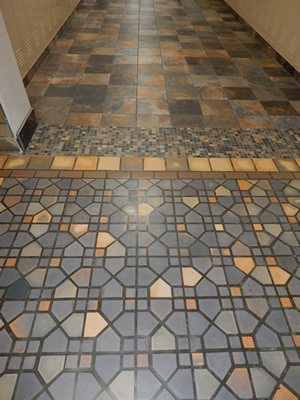
PHOTO © SCOTT BERMAN
Flooring can provide a durable foundation for an entire interior, help foster learning in spaces throughout a school, and serve as a way to make a bright, bold and beautiful design statement. The right flooring solution can be yet another vivid point of interest in renovation and new construction projects.
Standouts can include vivid, bold colors and patterns, flooring installed in renovation projects that adroitly complements, without attempting to duplicate, original flooring; as well as contrasts of colors and materials to denote different uses of spaces.
But how about design trends happening today and the process of choosing among many options? Some industry professionals recently shared insights with School Planning & Management magazine.
Flooring, like other components of interior design, happens in broad and changing contexts — first and foremost, learning and teaching.
Nick Alexandropoulos, Altro strategic marketing analyst, cites a peer-reviewed study by the University of Salford in the United Kingdom and architect IBI Group (formerly Nightingdale Associates) that, as he describes, suggests that the overall “design of a classroom can impact a child’s academic progress by as much as 25 percent (during) a school year” as well as boost morale, enhance safety and foster student collaboration.
As Lauri Watnee, healthcare segment director of Mohawk Group, sees it, “flooring trends reflect our ability to create learning environments that engage students and encourage active participation in learning.” She explains that “students learn in different ways and mobile technology means that learning opportunities can happen in any place at any time. Teaching methods are changing as well, requiring spaces to incorporate flexibility, adaptability and foster a deeper connection with the educational process.”
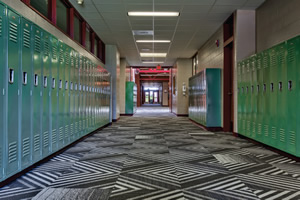
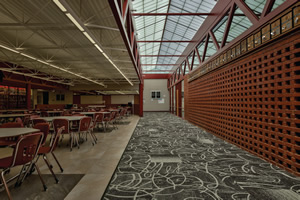
PHOTOS © MOHAWK
Stepping Up Productivity. A school’s flooring can serve as a way to make a bright, bold and beautiful design statement, be used as a method of wayfinding, include school colors and/or mascots, define schools within a larger campus and denote different uses of spaces. But researchers have also found that flooring, when selected to complement the design of specific learning spaces, can impact the students’ academic progress.
Watnee emphasizes the relationship between attractive interiors and important teaching and learning dynamics and how that relationship is spurring educational decision makers to explore interior design elements accordingly. “In K-12, we see a strong desire to create vibrant spaces that support and enhance the learning experience for both students and teachers.” She continues, “If student achievement is directly influenced by the facilities in which they learn, then creating spaces that support a changing learning process is a critical component.”
On a related note, Shannon Specialty Floor’s Ellie Dowden explains, “flooring design and the aesthetics of a classroom directly relate to the productivity in the space.”
Indeed, “one of the driving design principles for schools and our community today is about designing spaces where the occupants can learn and thrive,” says Kevin Sigourney, Consolideck product manager for PROSOCO.
There are helpful ways to go about the process of choosing flooring accordingly. “The flooring choice for us always begins with a discussion of the intended end use of the floor,” Sigourney explains. That triggers questions, such as “What is the space going to be used for? What type of and how frequent will the traffic be? Will the floor be exposed to spills or staining from chemicals? How much and what kind of maintenance is the school willing to do?” With answers to those questions in hand, design options emerge. “From there we then talk about finished concrete floor options and what design elements they want to incorporate in the floor,” Sigourney points out.
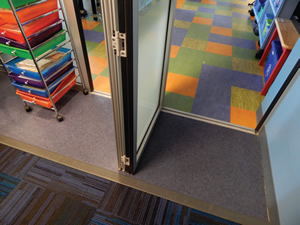
PHOTO © SCOTT BERMAN
With that in order, flooring can help express large ideas as part of an attractive interior. As Shannon Specialty’s Dowden says, “bringing colorful and whimsical designs to a classroom help create energetic, bright and cheerful working spaces.”
Maintaining a design that’s balanced is part of the process or journey toward the right flooring solution, whatever the product, form and material. As Altro’s Alexandropoulos puts it, “It’s obvious that you need durability, resiliency and stain resistance, but what’s often overlooked is aesthetics.”
Take for example, Hampden Academy in Maine, where Altro implemented a design that Alexandropoulos calls a “durable, attractive solution.” As he explains, “the school needed new flooring that could withstand heavy foot traffic but also opted for 11 different colors of the products in both chipped and nonchipped for aesthetic purposes.” The company describes “hues of creams, grays, yellows and blues” as well as a “terrazzo-flecked look (that) appealed to the client and enhanced the design.”
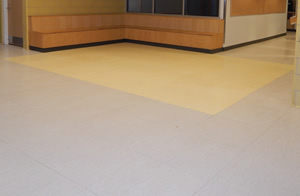
PHOTO © SCOTT BERMAN
Manufacturers are noting other color and style preferences. “We are really seeing an emergency of primary colors in the elementary education sector,” says PROSOCO’s Sigourney.
Watnee, meanwhile, sees “trends in using mixed patterns, changing pattern scale, unique sizes, geometric color blocking and the use of bright primary and secondary colors to bring energy to a space.” In an interesting example, they installed a product at Conestoga Junior/Senior High School in Nebraska, in a design that Watnee says was inspired by graffiti art and selected “with a tremendous amount of input from the students.” She describes the design as “bold, creative and (it) brings a high level of energy and pride to the school.”
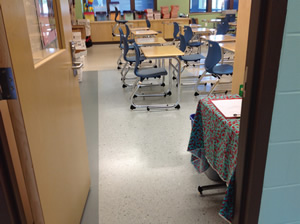
PHOTO © ALTRO
The company is also noting a significant trend in K-12 in the use of luxury vinyl tile (LVT), according to Watnee. She believes that LVT’s durability, easy maintenance and range of visuals, are all spurring that trend, which the company expects to continue.
There are many factors to consider, but not as many as there are options that can make floors a standout part of a school’s interior. As Watnee adds, “flooring does not only cover the floor and perhaps provide acoustic benefits; it is integral to the design of a great school.”
Thus, you can bet that what’s underfoot really does matter.
TIPS ABOUT FINDING AN ATTRACTIVE, DURABLE FLOORING DESIGN:
- Think through factors such as the amount of traffic on the floor, use and maintenance of the space. With such questions answered, focus on design elements, Kevin Sigourney suggests.
- “Don’t have tunnel vision,” suggests Altro’s Nick Alexandropoulos. Prioritizing design as well as safety is an important component of making “the perfect education environment.”
- “Focus on floors that feature both strong maintenance and durability features as well as great design,” says Ellie Dowden.
- Be bold. “Take a risk with color and pattern to create vibrant spaces that (generate) positive memories and pride with the school community,” adds Lauri Watnee.
This article originally appeared in the issue of .